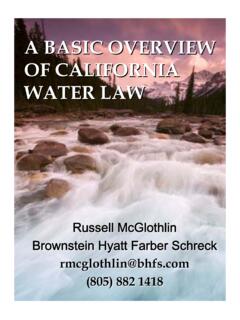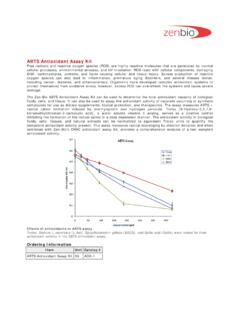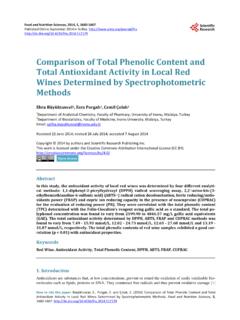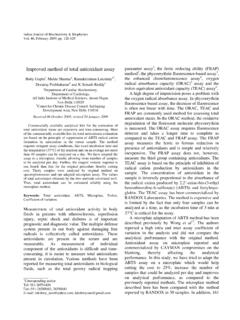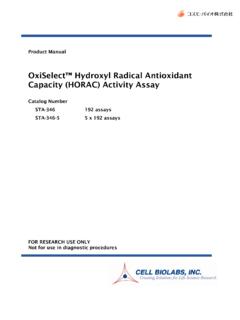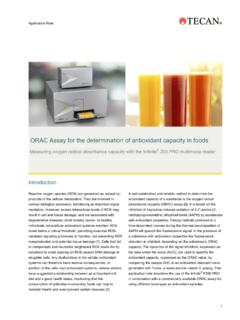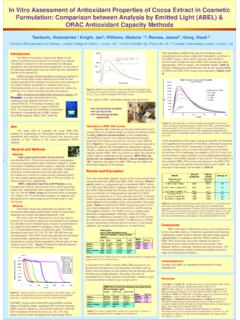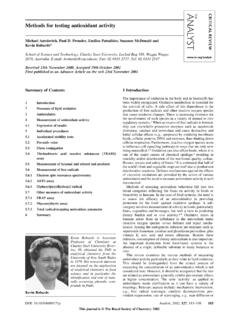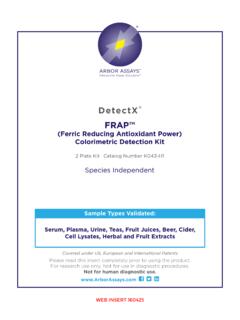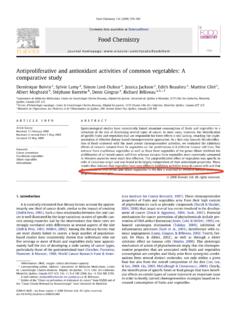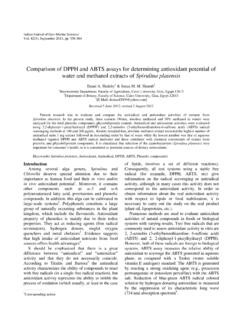Transcription of Extending Applicability of the Oxygen Radical Absorbance ...
1 Extending Applicability of the Oxygen Radical AbsorbanceCapacity (ORAC Fluorescein) AssayALBERTODA VALOS,CARMENGO MEZ-CORDOVE S,ANDBEGON ABARTOLOME *Instituto de Fermentaciones Industriales (CSIC), Juan de la Cierva 3, 28006 Madrid, SpainThe ORAC-fluorescein (ORAC-FL) method recently validated using automatic liquid handling systemshas now been adapted to manual handling and using a conventional fluorescence microplate calculated for Trolox, the precision of the method was< , expressed as percent coefficient ofvariation. The accuracy of the method was< , expressed as percent variation of the mean. Thedetection and quantification limits were those corresponding to and 1- M Trolox standard solutions,respectively. The method has been applied to 10 pure compounds (benzoic and cinnamic acids andaldehydes, flavonoids, and butylated hydroxyanisole), to 30 white, rose, and bottled- and oak-agedred wines, and to 7 commercial dietary antioxidant supplements.
2 All samples exhibited a good linearresponse with concentration. As seen by other methodologies, the chemical structure of a compounddetermines its antioxidant activity (ORAC-FL value). Of particular interest were the results with oak-aged red wines from different vintages (1989-2002) that confirm influence of vintage, but not originof the oak, in the antioxidant activity of wines from the same variety. Dietary antioxidant supplementspresented a great variability (170-fold difference) in their antioxidant potency. This work provesapplicability of the ORAC-FL assay in evaluating the antioxidant activity of diverse food : Antioxidant activity; ORAC; fluorescein; phenolics; wine; dietary antioxidant supplementsINTRODUCTIONA ttempts to develop methods for assaying antioxidant activityagainst reactive Oxygen species (ROS) are fully justified by theimplications of ROS in the pathogenesis of several chronicdiseases, and in general, in the aging process.
3 In the late eighties,Glazer (1,2) developed an assay to measure hydrophilicantioxidant activity against ROS based on the detection ofchemical damage to R- or -phycoerythrins (PEs) through thedecrease in their fluorescence emission. PEs were exposed eitherto peroxyl radicals, generated by thermal decomposition of 2,2 -azobis(2-methylpropionamidine) dihydrochloride (AAPH), orto hydroxyl radicals, generated at copper-binding sites onmacromolecules in the presence of ascorbate and Cu2+.Inthepresence of peroxyl radicals, the decay in the fluorescence ofPE followed a zero order ( , linear with time) kinetic, andthe antioxidant capacity of a compound/mixture was related tothe increase observed in the lag phase and/or to the decrease inthe rate constant. Using -phycoerythrin as fluorescent probeand AAPH as free Radical initiator, Cao and co-workers (3,4)quantified the protective effect of an antioxidant by assessingthe area under the fluorescence decay curve (AUC) of thesample as compared to that of the blank in which no antioxidantwas present.
4 Results were expressed as Trolox equivalents. Thismethodology was named as the Oxygen Radical absorbancecapacity (ORAC) assay , and it is still one of the few methodsthat combines both inhibition percentage and inhibition timeof the reactive species action by antioxidants into a singlequantity (4). The ORAC assay has been largely applied to theassessment of free Radical scavenging capacity of human plasma,proteins, DNA, pure antioxidant compounds and antioxidantplant/food extracts (see5for references). The principal drawbackof this assay is the PE itself, since it varies from lot to lot, isnot photostable, and can be photobleached after an exposure toexcitation light (6). Additionally, it was observed that PEinteractions with polyphenols could cause erroneous ORAC values (6). Considering these disadvantages, Ou and co-workers(6) developed and validated an improved Oxygen radicalabsorbance capacity assay using fluorescein (FL) as thefluorescent probe (ORAC-FL).
5 FL as compared to PE doesnot interact with antioxidants, shows an excellent photostability,and reduces the cost of experiments (6). The ORAC-FL assaywas further extended to lipophilic antioxidants by using me-thylated -cyclodextrin as water solubility enhancer (7).The Oxygen Radical Absorbance capacity assay using fluores-cein (ORAC-FL) method was developed on a COBAS FARAII centrifugal analyzer with fluorescence-measuring attachment(Roche Diagnostic System Inc., Branchburg, NJ), that couldanalyze up to nine samples at a single concentration per run(6). Recently, the ORAC-FL has been fully automated by usinga multichannel liquid handling system (robotic) coupled with amicroplate fluorescence reader in 96-well format, that improvedthe efficiency of the assay 10-fold (8). Automation indeedreduces time analysis and improves efficiency in large scale* To whom correspondence should be addressed.
6 Tel.: 34 91 : 34 91 5644853. E-mail: Agric. Food ,52,48 CCC: $ 2004 American Chemical SocietyPublished on Web 12/16/2003analyses, but it is available in few laboratories. Small labora-tories from public research Institutions/universities and fromquality and control or research and development industrydepartments would still use manual handling for the ORAC assay , because they do not need to analyze many samples everyday. In this paper, we adapted the ORAC-fluorescein assay tomanual handling, and using a conventional fluorescence platereader. The antioxidant activity of several pure compounds andfood (solid and liquid) samples was determined by the adaptedORAC-FL method. Wine was chosen as a liquid samplebecause of its high content in antioxidant phenolics ( ,anthocyanins, catechins, and flavonols) and dietary antioxidantsupplements as solid samples because they contain differentantioxidant-type compounds ( , vitamins, carotenoids, andflavonoids).
7 The literature contains very few studies about theantioxidant activity measurement by the ORAC method for bothwine (4) and dietary antioxidant supplements (9).MATERIALS AND , disodium salt, -Phycoerythrin (PE), butylatedhydroxyanisole (BHA), 3,4-dihydroxycinnamic acid (caffeic acid) and(+)-catechin were purchased from Sigma (St Louis, MO). 6-Hydroxy-2,5,7,8-tetramethylchroman-2-c arboxylic acid (Trolox), 2,2 -azobis (2-methylpropionamidine) dihydrochloride (AAPH), 3,4-dihydroxybenzoicacid (protocatechuic acid), 4-hydroxy-3-methoxycinnamic aldehyde(coniferyl aldehyde), and 5 -caffeoylquinic acid (chlorogenic acid) wereobtained from Aldrich (Milwaukee, WI). 4-Hydroxy-3-methoxycin-namic acid (ferulic acid), 4-hydroxycinnamic acid (p-coumaric acid),and 3,4-dihydroxybenzoic aldehyde (protocatechuic aldehyde) werepurchased from Fluka (Buchs SG, Switzerland).
8 Quercetin wasobtained from Koch-Light Laboratories Ltd. (Colnbrook, England). ForORAC-FL assessment, standards were dissolved in<200 Lofmethanol and made up to the final volume with 75 mM phosphatebuffer (pH ). A fluorescein stock solution ( mM) was made in75 mM phosphate buffer (pH ) and was stored at 4 C for 4 weeks. -PE solution ( nM), AAPH, and Trolox solutions in 75 mMphosphate buffer (pH ) were prepared white wines (var. Verdejo from Ruedaappellationcontro le e(Valladolid, Spain) and var. Albarin o fromRias Baixasappellation contro le e(Pontevedra, Spain)) and three rose (var. Cabernet-Sauvignon fromSomontano appellation contro le e(Huesca, Spain), fromMe ntrida appellation contro le e(Toledo, Spain), andvar. Garnacha fromNaVarra appellation contro le e(Pamplona, Spain))wines from the 2002 vintage were obtained from local markets.
9 Twenty-five red wines were provided by EVENA (Viticulture and EnologyStation of Navarra, Olite, Navarra, Spain). Three of them correspondedto bottled-aged wines elaborated from grapes of var. Graciano,Tempranillo, and Cabernet-Sauvignon from the 2000 vintage. The restof them corresponded to oak-aged wines elaborated from grapes ofvar. Tempranillo and Cabernet-Sauvignon from the 1989, 1992, 1995,2000, 2001, and 2002 vintages. These wines were aged in barrels fromAmerican or French ( ) oak for one year, except for 2002wines that were aged for three (var. Tempranillo) or four (var. Cabernet-Sauvignon) months. For ORAC-FL assessment, wines were dilutedas convenient with 75 mM phosphate buffer (pH ). Total polyphenolcontent in wines was determined according to the Folin-Ciocalteaumethod (10), using gallic acid as a standard.
10 The results were expressedas mg of gallic acid equivalents (GAE) per Antioxidant commercial dietaryantioxidant supplements (named #1-7) were obtained from localmarkets. According to the manufactures, they contain grape extracts(#1-#5 and #7), vitamin C (#5-#7), vitamin E (#5 and #7), carotenoids(#5 and #7), citrus flavonoids (#6 and #7), yeast rich in selenium (#5and #7) and others. Different quantities ( g for #4; g for #3; g for #1, #6, and #7; g for #2; 2 g for 5#) of dietary antioxidantsupplements were dissolved in methanol and centrifuged (2000 rpm,10 min), and the supernatant was collected for analysis. For ORAC-FL analysis, supernatants were diluted as convenient with 75 mMphosphate buffer (pH ). Two different batches of each supplementwere Polarstar Galaxy plate reader (BMG LabtechnologiesGmbH, Offenburg, Germany) controlled by the Fluostar Galaxysoftware version ( ) was used.







